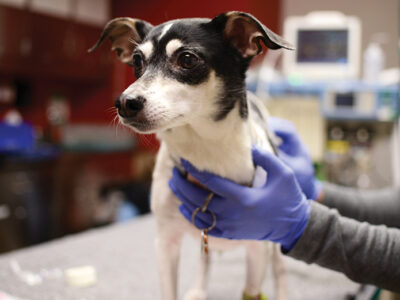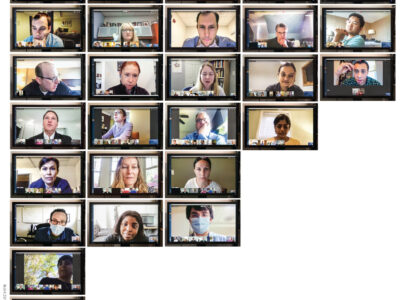
Six years ago surgeon Joseph Friedberg EAS’81 had a 47-year-old patient who was diagnosed with lung cancer. It appeared to be a Stage I cancer, the kind that is normally treated with surgery. But when Dr. Friedberg opened up his patient’s chest in the operating room, he found something else, something that hadn’t shown up in any of the preoperative studies: the lining of the chest cavity “was just totally studded with little collections of cancer,” says Friedberg. It was Stage IIIB of what’s known as non-small cell lung cancer, meaning this patient would probably have no more than six to nine months to live.
When a surgeon sees that, Friedberg says, “you just close [up the opening]. Because of the advanced stage, the cancer has already spread, and taking out the primary tumor does nothing to alter the patient’s life expectancy.”
But Friedberg’s patient was determined to see his daughter, then a junior in high school, graduate. “There’s got to be something else you can do,” he told the surgeon.
There was. Friedberg, now chief of thoracic surgery at Philadelphia’s Thomas Jefferson University Hospital, and Dr. Stephen Hahn, Penn professor of radiation oncology, had teamed up before this patient’s diagnosis and developed a protocol for treating advanced lung cancer with a light-based therapy called photodynamic therapy. While PDT has been used for several decades to treat cancers that are small and easy to see, Friedberg’s team was one of the few in the world using PDT to treat other types of cancers. Now Friedberg and Hahn considered another possibility: What if they combined surgery with the photodynamic therapy for this advanced lung cancer—that is, removed the patient’s main cancer and used PDT to treat the lining of his chest cavity at the same time?
“It was experimental: we had done this safely with other cancers and had favorable results, so we were willing to try,” Friedberg says.
That was the beginning of an ongoing clinical trial that has enrolled more than 20 patients. Friedberg was very aware of the trial’s importance. “People don’t realize that lung cancer is the number-one cancer killer of both women and men,” he says. In fact, each year more people die of lung cancer than of breast, colon, and prostate cancer combined.
Among all cancers, non-small cell lung cancer is particularly pernicious. It’s hard to catch early and treat, says Friedberg, “because it’s usually asymptomatic until it’s at a very advanced stage.” For the Stage IIIB disease that Friedberg and Hahn are treating in the trial, chemotherapy alone is the traditional treatment.
In Friedberg’s new approach, treatment begins with chemo-therapy until the cancer stops responding. Then, a day before the surgery, a light-sensitive drug called Photofrin is injected into the patient’s bloodstream. Over the next 24 hours, cells all over the body absorb the Photofrin. For reasons that aren’t yet known, cancer cells tend to take up the largest share of Photofrin. In the operating room, Friedberg removes every visible sign of cancer from the patient’s chest. Then PDT is delivered in an attempt to deal with any cancer cells that can’t be removed through surgery: A laser light is shined in the chest cavity to activate the Photofrin, which in turn produces a form of oxygen that kills the cancer cells.
From this small trial emerged two exciting results: First of all, historical trials show that for patients undergoing surgery only, the lung cancer comes back ninety percent of the time. But combine surgery with PDT and there is a dramatic reduction in local recurrence—that is, the cancer is extremely unlikely to grow back in the chest cavity. That part was not a surprise, says Friedberg. “If you operate and the cancer comes back, that tells me that some microscopic or invisible disease remains after the surgery. And that is what we’re targeting with the PDT.”
The second outcome of the trial was unexpected. In the past, for patients with this stage of lung cancer, combining surgery with the chemotherapy didn’t change the usual survival of six to nine months—so surgery was not usually considered part of the treatment. But surgery and PDT together yielded a different result: the median survival for patients in Friedberg’s trial was three or four times longer.
“That part wasn’t clear to me —and still isn’t,” he says. “There may be some sort of systemic effect from the light therapy that we have not anticipated.”
To glean more clues, Friedberg turned to Dr. Sandra Gollnick, a researcher from Roswell Park Cancer Institute in Buffalo. “She’s done some incredible experiments on the systemic effects of PDT, where cancer cells from a mouse are killed using PDT and then injected back into a mouse, kind of like a vaccine,” he says. “If you then try and grow the same tumor in the mouse, it doesn’t grow.”
The parallel with Friedberg’s trial patients is intriguing. “It’s possible that when we’re treating these patients, the cancer cells not only get killed [by PDT] but somehow are picked up by the immune system and kind of supercharge it, so it’s more effective in dealing with the cancer.” Using PDT also seems to inhibit the development of other cancers.
So is a tumor vaccine for humans in the works?
“Everybody’s in the tumor-vaccine business,” he says, but “that’s one of the things we’re trying to explore.” Friedberg thinks his team is uniquely positioned to make progress on that front by capitalizing on its recent work with PDT.
Friedberg’s 47-year-old patient, the first in his clinical trial, lived two more years after the combination of surgery and PDT. Some people question “whether that was enough to make the treatment worth it,” Friedberg says. “He thought so. He did live to see his daughter graduate from high school.”
Friedberg and Hahn would like to expand the trial to a larger group of patients and continue trying to improve survival times.
“I’m interested in seeing how it works, making it work better and helping people with it,” he says. “It’s pretty gratifying when that happens.”
—Sonia Ellis EAS’86




